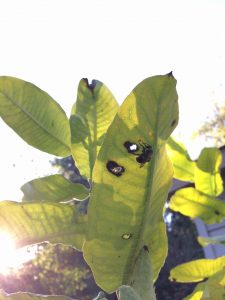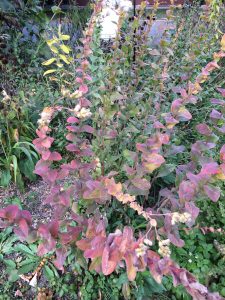by Stephanie Walquist

Sprezzatura
Rembrandt, an Old Master who used earth tones to offset golden light, used a technique he termed sprezzatura, meaning apparent carelessness. In the spirit of artistic and environmental sensibilities, let us native gardeners unite under this term. Allowing the gardens to stand during fall and winter, we might appear careless about the gardens, but, instead, we are intentionally caring for biodiversity.
Let’s Revel
Standard gardening wisdom says to cut everything down when things start to die. This would be a loss–nothing to look at as well as the devastation to the animals that depend on our yards. Instead of cutting our plants down because they do not conform to conventional garden aesthetics, it’s time to unlearn that habit of seeing and learn to appreciate these plants and their colors as they prepare for winter. We are in good company, like the Old Masters, or Piet Oudolf, designer of Lurie Gardens. Let’s revel in the glorious golds, maroons, vermillions, siennas, and umbers that decaying plants offer us.
This attitude might be a relief too if you’ve felt like you failed because you didn’t have fall interest or winter interest and feel like you have to work hard to get plants that have structures to rival flowers all year long. The good news is that if you have plants around you, you already have fall and winter interest.
Expand our color vocabulary

Let’s change our aesthetics, our idea of what’s beautiful. We could start to look at the yellows of Common Milkweed with a new appreciation while expanding our color vocabulary. Right now, the leaves on my milkweed are chartreuse with some at the top a glowing gold as they hold the sunlight. Later, they will be more of an ochre as the sun moves overhead.
Brown is a beautiful color–there are so many shades of it, and when the light hits brown leaves, they can look purple or red in hue. The stems and leaves on White Snakeroot are a gorgeous russet color. Some of the milkweed stems are a toasted almond color, with the veins becoming more mahogany. The Rose Milkweed leaves are a dark ivy green with mottling of plum and rose hues. It just takes a few moments to start to see the beauty in decaying plants.
The science behind the beauty
These colors are produced by chemical pigments, adding an extra layer of interest as we look at different plants and notice what their fall colors are once chlorophyll production begins to subside. The Common Milkweed’s yellow is an outcome of xanthophyll and carotenoids. But Rose Milkweed usually turn wine-colored, which is the result of anthocyanin. Does that impact Monarch caterpillars? Science and art always end up overlapping.
As the fall progresses, and plants begin the process of shutting down, let’s challenge ourselves with seeing the beauty in the autumnal palette of decay, making way for winter, readying for spring.
